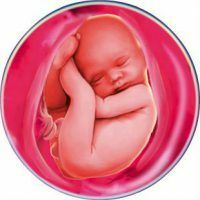
Before you begin to count the duration of the pregnancy, you need to get acquainted with two concepts - real and obstetric term. The actual period of pregnancy is counted from the moment of fertilization. Obstetric - from the first day of the last menstruation. The difference between them is about 2 weeks on average. The hospital sheet indicates obstetric pregnancy. Therefore, fetal development begins at week 3.
- 1st week
- 2nd week
- 3rd week
- 4th week
- 5th week
- 6th week
- 7th week
- 8th week
- Week 9
- 10th weekweek
- 11th week
- 12th week
- 13th week
- 14th week
- 15th week
- 16th week
- 17th week
- 18th week
- 19th week
- 20th weekWeek
- Week 21
- Week 22
- Week 23
- Week 24
- Week 25
- Week 26
- Week 27
- 28th week
- The 29th week
- 30th weekweek
- 31st week
- 32nd week
- 33rd week
- 34th week
- 35th week
- 36th week
- 37th week
- 38th week
- The 39th week
- The 40th week
The 1st week

During this period fertilization took place. The fruit is very tiny and it is practically impossible to fix it on ultrasound. Implantation of the embryo takes place. Begins the restructuring of the body and the production of a hormone, which is responsible for protecting the fetus during pregnancy. The formation of the placenta and umbilical cord also occurs.
No signs of pregnancy are observed in the first week. However, some women already feel drowsiness, weakness, heaviness in the lower abdomen. The same symptoms with premenstrual syndrome. A distinctive feature may be implantation bleeding - a small discharge of pink or brown.
2nd week
Differences from the first week are minor. In the second week the fetus increases by 1/10 of its total size. The placenta continues to form and begins to function.
There is a drawing pain in the lower abdomen, there may be pink discharge. It is important to consider that abundant brown discharge may indicate a miscarriage. They are often confused with menstruation.
to contents ^3rd week
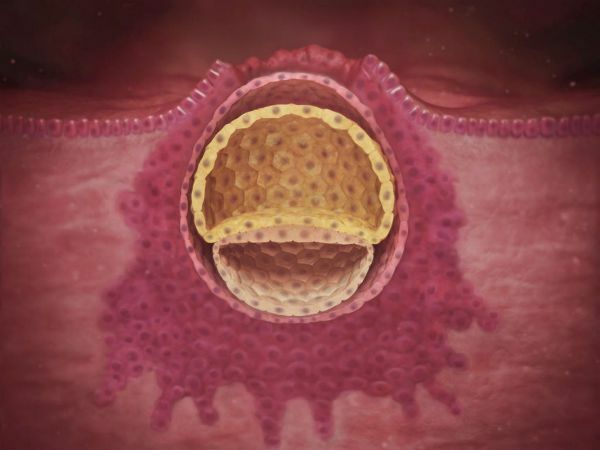
The fruit looks like a small cellular thickening that can already be fixed on ultrasound. Its diameter varies from 0.1 to 0.2 mm, weight - 2-3 μg.
Some women have more urge to urinate, there is a toxicosis. The number of excretions may increase or decrease sharply. It is important to pay attention to their color and smell. Any abnormalities can indicate the presence of infection.
to table of contents ^4th week
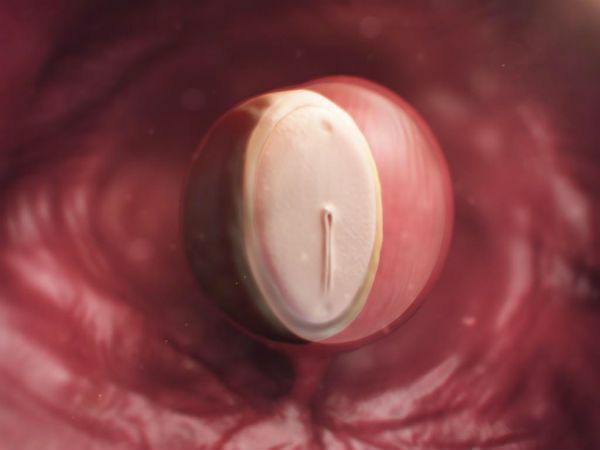
Fetal size - 5 mm, weight - 0,5 mcg. Externally, the fruit resembles a three-layer disc. Subsequently, each layer( ectoderm, mesoderm, endoderm) will be responsible for the formation of certain organs. Embryonic organs develop - chorion, amnion, yolk sac.
The woman's appetite noticeably increases. The abdomen is slightly rounded, the waist changes shape. The emetic reflex increases, and intolerance of odors arises. There is a sharp change of mood, irritability, emotional instability. The mammary glands gain volume, the sensitivity of the nipples increases.
to contents ^5th week
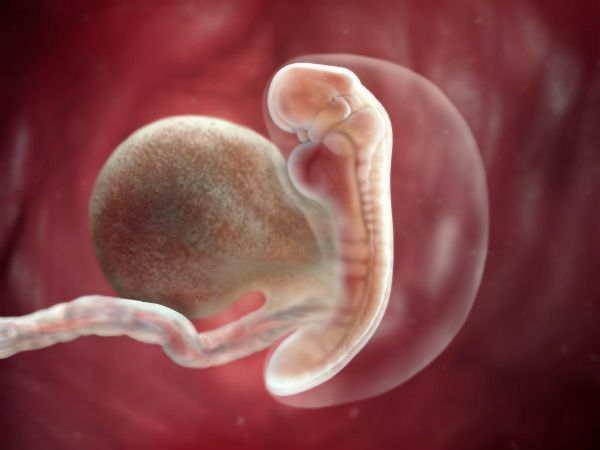
Fetal size - 4-7 mm, weight - up to 1 gram. A spinal cord with a neural tube is formed. Then they form the center of the nervous system. The organs of the digestive system begin to form( liver, pancreas, kidneys, adrenals).The thyroid gland and heart are formed. Formed blood vessels have already begun to attach to it.
Nausea worries a woman at any time of the day. The probability of miscarriage increases, especially with increased content of male hormones. Unusual odor and color of discharge, and aching pain in the lower abdomen signal the presence of problems.
to contents ^6th week
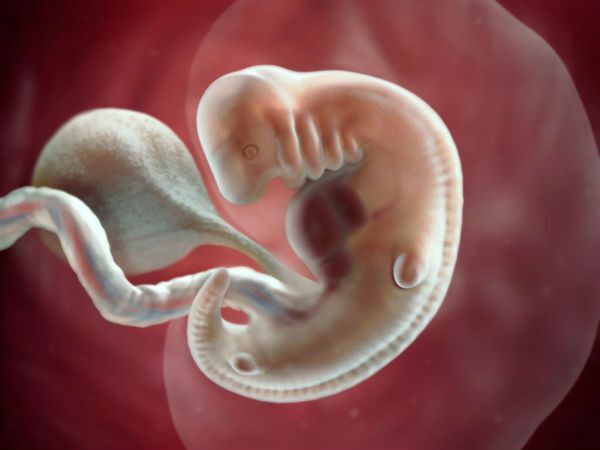
Fetal size - 4-9 mm, weight - 0.9-1.3 grams. The fetus begins to stir. The nervous system of the fetus is formed. The brain begins to develop, grooves and convolutions are formed, the cranium is formed. There are rudiments of hands and feet. The cartilage system develops.
The woman has a tingling in her chest. There is bloating due to intestinal surgery. The rest of the sensations are the same as in the previous weeks. Toxicosis continues, and should be alerted to the sudden termination of it. Such changes happen with the fading of pregnancy.
7th week
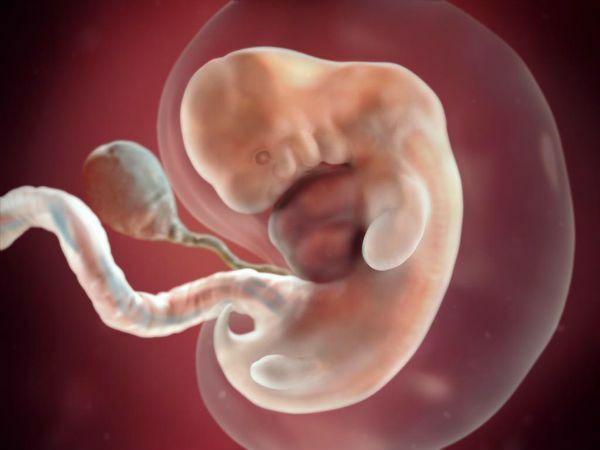
Fetal size - 13 mm, weight - 1,1-1,3 grams. Start to form fingers, neck, ears, face. The eyes are far apart from each other. The heart is completely formed, 2 atria and 2 ventricles were allocated. Erythrocytes appear, and the Rh factor of the fetus is determined. The intestine of the fetus grows in length, appendix and large intestine are formed. The pancreas begins to produce insulin. Bile ducts formed in the liver. Develop kidney and reproductive system.
The mother has headaches. It can lower blood pressure, which leads to dizziness and fainting. Significantly increases the sensitivity of the nipples. They become darker. Breasts increase. Constipation, bloating and heartburn occur. There is swelling of the extremities.
to table of contents ^8th week of
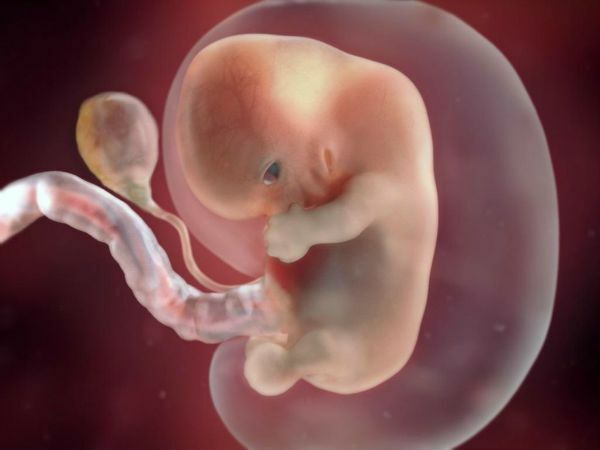
Fruit size - 14-20 mm, weight - 1.5 grams. Many bodies have already been formed and have even begun to function. The heart became four-chambered, vessels and valves were formed. The facial features become more distinct. The tongue develops papillae.
The sweat and salivary glands are formed, the digestive and excretory systems begin to work. Ovaries are formed in girls and testicles in boys. Diaphragm and bronchial tree begin to form. Develop joints and muscles, phalanges of fingers. Ossified hands, feet and skull.
The uterus grows and there is pain in the area of the bladder. Due to irritation of the sciatic nerve, there is a burning pain in the pelvic region and thighs. Changing cravings in food. The skin condition worsens. There is a varicose disease. It should be noted that nausea at this time should not be more than 2 times a day.
to contents ^9th week

Fetal size - 22-30 mm, weight - 2 grams. The brain and the nervous system are already formed. The cerebellum, the pituitary gland, the middle layer of the adrenal glands, the lymph nodes, the mammary glands, the sexual organs are formed. Appear cranial, intervertebral and spinal nerves. The excretory system functions.
The mother's abdomen is rounded, the chest grows, and a varicose net appears on it. The urge to urinate is doubled. Despite a tired state and a decline in strength, insomnia appears.
10th week
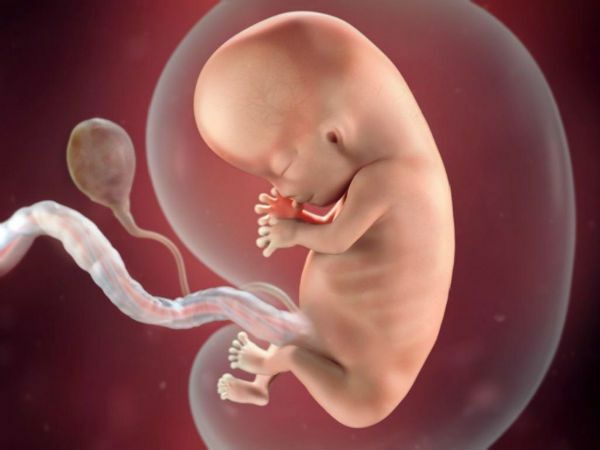
Fetal size - 3-4 cm, weight - 4-5 grams. The nervous system was formed and divided into central and peripheral. The brain produces neurons and controls all the fetal systems. The immune and lymphatic systems are formed, the diaphragm is formed.
Teeth appear. The muscular and bony system develops. Handles and legs are fully formed, and the fruit actively moves them. Marigolds began to form on the fingers. Taste and olfactory receptors developed. The face is fully formed. The fruit opens and closes the mouth.
Toxicosis begins to disappear, but pain and dizziness do not stop. Appetite appreciably increases. Some women are concerned about constipation and heartburn. A pigmented strip on the abdomen is formed due to the synthesis of melanin.
to the table of contents ^11th week
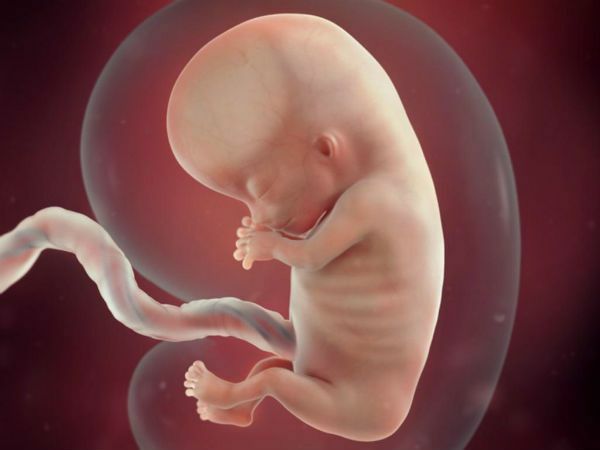
Fetal size - 5 cm, weight - 7-8 grams. The placenta is becoming stronger every day. The intestine temporarily unites with the umbilical cord. The brain and the conductivity of the nervous system increase. The sense of smell, genitals, digestive tract, teeth, joints, vocal cords, taste, olfactory and tactile receptors are formed. Reflexes develop, especially sucking and grasping. The fetus begins to react to stimuli from the outside.
Woman feels the movement of the child. The susceptibility to smells, sensitivity and soreness of the breast decreases. The general condition is normalized.
to contents ^12th week
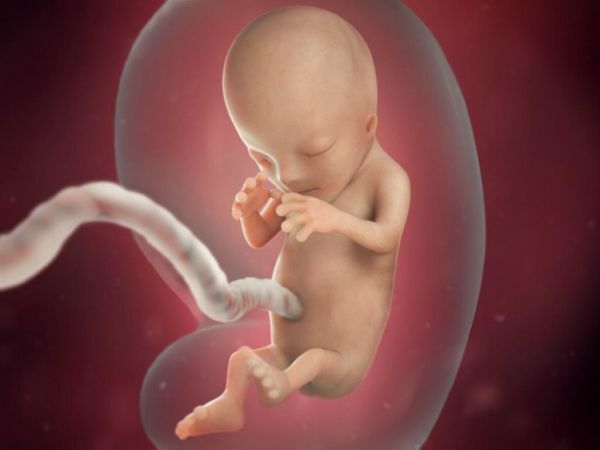
Fetal size - 6-9 cm, weight - 14 grams. Due to the development of the nervous system, there is a connection between the hemispheres and the spinal cord. All systems of the body are formed and began to function. The heart supplies them with blood. In addition to red blood cells, leukocytes were formed in it. The liver began to produce bile, and now the fetus absorbs fats. A sucking reflex develops. There is a fluff on the head, chin, the area above the lip, the place of eyebrows and cilia.
Passed sharp mood swings, nausea, drowsiness, loss of strength. Desires to the toilet are less likely. Increases the sensitivity of the skin, there is itching.
to contents ^13th week

Fetal size - 7-10 cm, weight - 15-25 grams. The heart actively pumps blood. The formation of the reproductive system is being completed. Fully filled with baby teeth. The body develops faster than the head. The bone system is formed. The limbs are lengthened. Fingers bend, a prototype of prints appeared on them.
Women no longer worry about pregnancy symptoms. The stomach is rounded and begins to bulge. The waist is almost invisible. There is a feeling of tension in the legs, increasing the risk of varicose veins.
to contents ^14th week
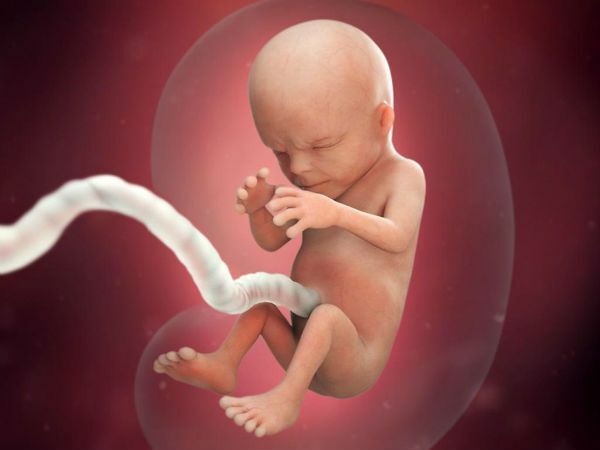
Fetal size - 9-11 cm, weight - 30-40 grams. The chest, diaphragm, intercostal muscles, musculature develop. The fruit swallows the amniotic fluid and senses its taste, sucks the finger. Nasal bridge and cheeks formed. The fetus uses mimic muscles.
Temporary pain in the groin and sides - a normal phenomenon, provided that they do not have a cramping character. There is fragility of hair and nails, peeling and dry skin. The skin is stretched and thinned, and stretch marks are formed. There is bleeding gums.
to contents ^15th week
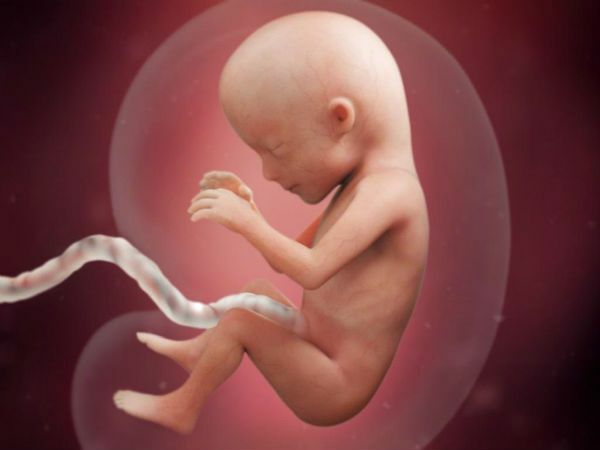
The fruit size is already more than 10 cm, weight is about 70 grams. Blood vessels develop. Blood to the organs enters the arteries. The skeleton begins to sting. The child can bend his hands in the elbows, squeeze his fingers. The face changes. The eyes become closer and take a natural position. The skin is so thin that blood vessels are visible through it.
Some women feel power, others - decline. There may be rhinitis, nosebleeds, night suffocation. The abdomen noticeably increases in comparison with 14 weeks.
to table of contents ^16th week
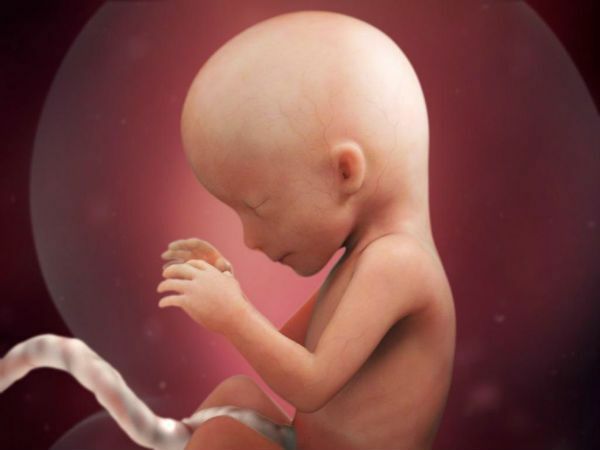
Fetal size - 11-13 cm, weight - about 100-120 grams. The ultrasound can determine the sex of the child. The girls formed a set of eggs. The composition of the blood is completely formed. Nerve cells are formed - neurons. Nerves are covered with organs. The convolutions and furrows of the brain increase. The body becomes proportionate, the neck is strengthened, the fruit holds and turns its head.
A woman is not disturbed by frequent urge to go to the toilet. But heartburn and constipation does not pass. There may be shortness of breath and a feeling of lack of air.
to contents ^17th week
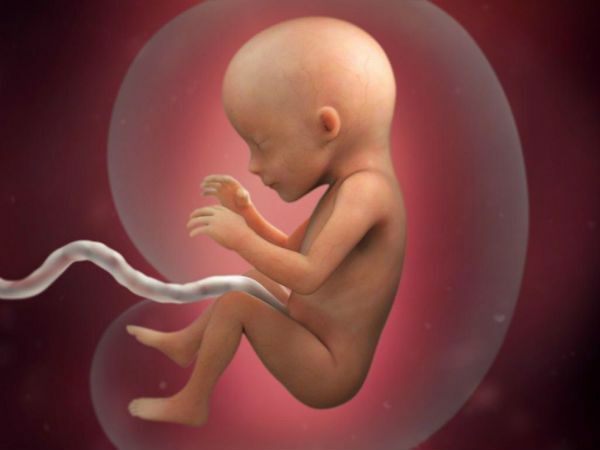
Fetal size - 13 cm, weight - 140 grams. The ultrasound shows all organs of the fetus. Subcutaneous fat is formed. Bronchias and alveoli developed. Sweat glands, joints, almost completely muscular system and auditory organ were formed. The muscles contract, so the fetal head straightens.
A woman feels a stirring. The volume of circulating blood increases, so urination becomes more frequent. Seizures can reduce calf muscles.
to contents ^18th week

Fetal size - 14 cm, weight - 190-200 grams. Endocrine and nervous systems develop. Interferon and immunoglobulin are released. The thymus is formed and secretes lymphocytes. Vocal cords and a hearing organ have been formed. The size of the brain and head increases.
The fruit releases more metabolic products, which in turn affects the emotional state of the mother. There is nervousness. A woman feels the pressure of the uterus on the abdominal wall and adjacent organs.
to contents ^19th week
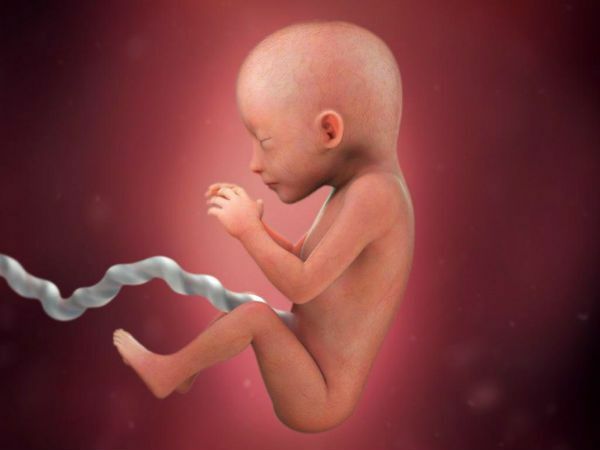
Fetal size - 15.3 cm, weight - about 250 grams. In the brain, the departments responsible for hearing, sight, taste, smell, and touch are formed. A connection is established between the brain and spinal cord and the systems. Light, almost formed bronchial tree develops. The spleen begins to function.
The woman has heartburn and swelling, intestinal motility is disrupted due to the displacement of the organs by a growing uterus. Increases sweating because of the increased work of the thyroid gland. The abdomen is large, so it is more difficult to choose a comfortable pose for sleep.
to contents ^20th week

Fetal size - 16 cm, weight - about 300 grams. The organs are formed, but are not ready to function outside the mother's body. The fetus reacts to light stimuli. Turns and grabs by the umbilical cord. Knows how to yawn, frown, smile, hiccup.
The center of gravity shifts because of the growing abdomen, and the woman starts to hurt back. The bandage relieves stress and reduces discomfort. Puffiness on the legs, ankles and fingers is increasing.
to table of contents ^21st week
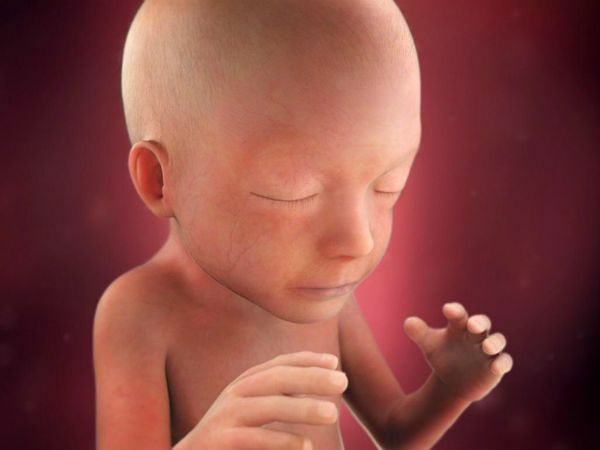
Fetal size - 27 cm, weight - about 360 grams. The digestive system prepares to function outside the mother's body. The fetus sleeps up to 20 hours a day and constantly sees dreams.
The abdomen of the pregnant woman becomes noticeably larger, and the load on the back and legs increases. Breasts become larger, and areoles are darker. Periodically there are dizziness, shortness of breath, a feeling of lack of air.
to table of contents ^22nd week
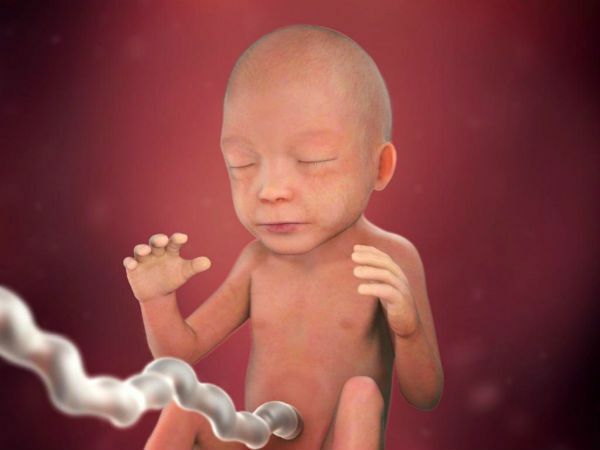
Fetal size - 28 cm, weight - about 430 grams. The development of the brain is completed, and neural connections are established. Develop tactile sensations. The child reacts actively to light and sounds, and the woman feels it.
Pain in the back, shoulders, legs, which does not last until the end of pregnancy, increases. It is important to control the level of pressure and hemoglobin in the blood to prevent the development of anemia.
to table of contents ^23rd week of
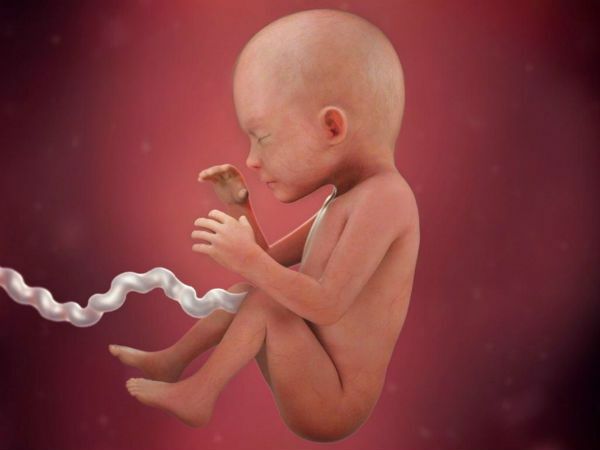
Fetal size - 29 cm, weight - about 500 grams. All systems and organs function, from that moment in the case of premature birth the child will survive. The fetus has a certain mode of life. A woman can determine at what time he is awake and when he is resting. Shoes become small, because the foot is lengthened due to the development of flat feet.
to contents ^24th week
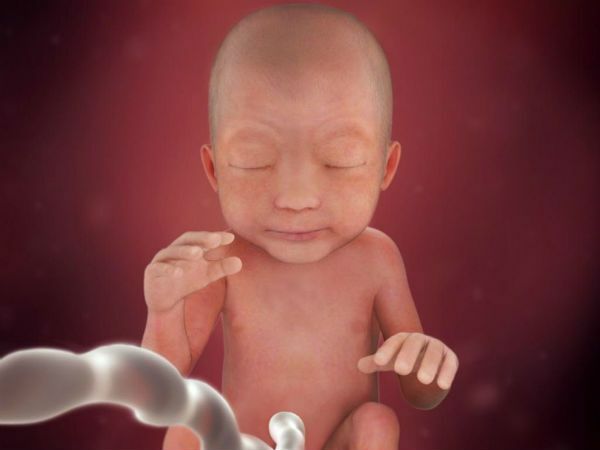
Fetal size - 30 cm, weight - up to 600 grams. The child actively gaining weight, accumulates fatty tissue, and it becomes cramped in the uterus. Brown fat is deposited mainly on the tummy and in the area between the scapulae.
Pushing feels not only the mother, but also the father, if he puts his hand to the stomach. There is a digestive disorder due to compression of the liver and gallbladder by the uterus. At this time, the woman's skin and hair condition improves.
to contents ^25th week
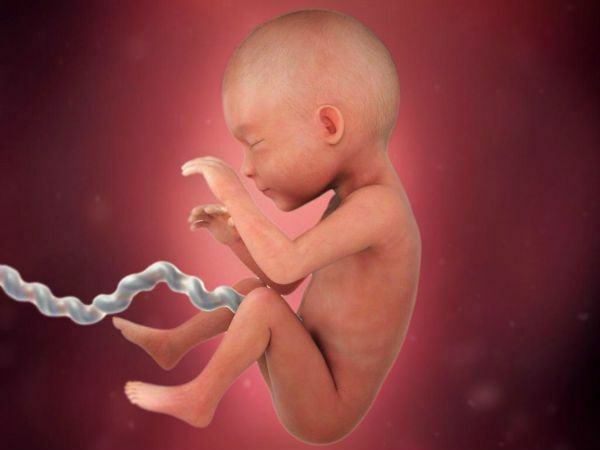
Fetal size - 34.5 cm, weight - 660 grams. All parts of the brain are formed, and its weight is 100 grams. The formation of the lungs was completed. The face is formed. It is determined which hand will become the leading one, right or left. The fetus is able to distinguish between voices and sounds and to respond to them. Can grip the ears with pens and push, hearing sharp sounds.
The growing abdomen presses against the diaphragm. A woman is harder to breathe, there is shortness of breath. The amount of secretions( colostrum) from the nipples increases.
to table of contents ^26th week
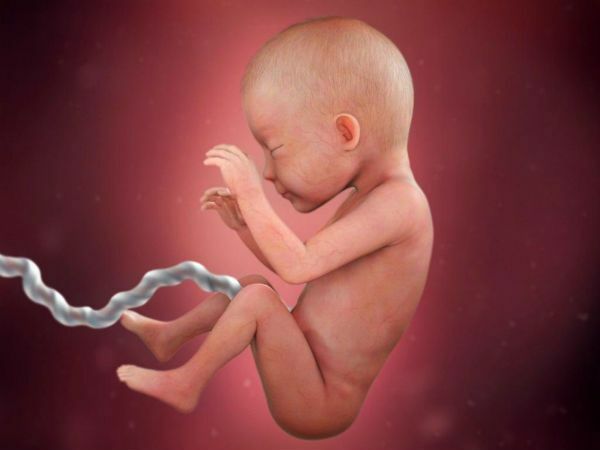
Fetal value - 35.5 cm, weight - 760 grams. The baby's skin is smoothed and changes color. The adrenal glands of the fetus begin to produce growth hormone. The kid periodically rests against the mother's ribs, which causes pain. The fruit will change position if you lie on your side, stroke your stomach or talk a little. Increased fatigue, drowsiness, some women have fainting.
to contents ^27th week
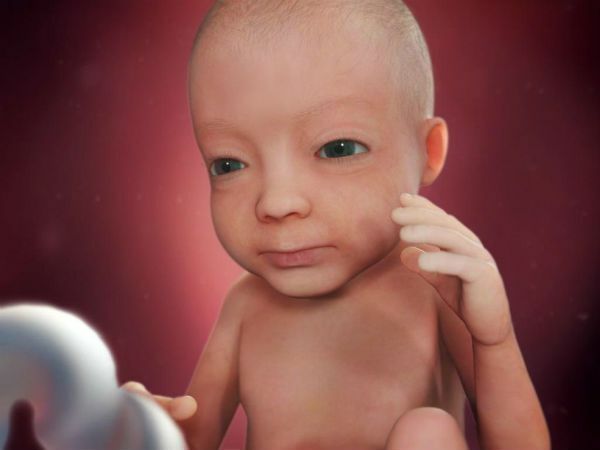
The fruit size is more than 36 cm, weight reaches 900 grams. The endocrine system is actively developing. The kid is already opening his eyes. Tactile sensations increase, so the fetus feels everything around. A woman feels aching pain in her lower back and muscles. Nausea and weakness appear. In secretions from the genital organs there should be no admixtures of blood or pus.
to contents ^28th week
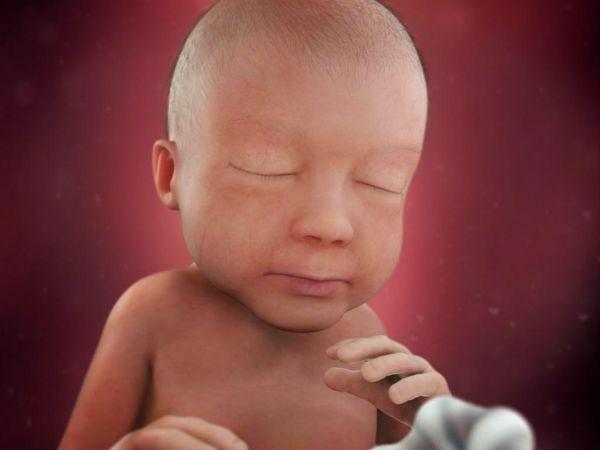
The fruit size is 38-38.5 cm, weight is about 1 kg. The body is preparing for oxygen exchange with blood. The baby's thorax moves rhythmically. Disappears the pupillary membrane from the eyeballs, so the child reacts more sharply to light. The abdomen continues to grow, and pain in the back and legs increases. There may be nausea due to squeezing of the digestive system.
to table of contents ^29th week of
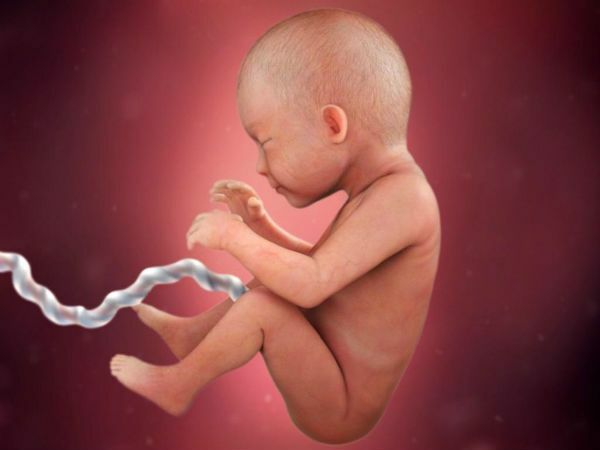
Fetal size - 38.6 cm, weight - 1150 grams. The nostrils of the fetus are freed from mucous plugs, so it smells. The child fixes a look at the interesting details. The fruit accumulates white fat, and its body is rounded. All organs and systems work as a single organism.
The volume of circulating blood increases, and the woman's pulse increases, and the pressure decreases. Vessels are dilated, and protruding veins appear on the arms, feet and stomach.
to contents ^30th week
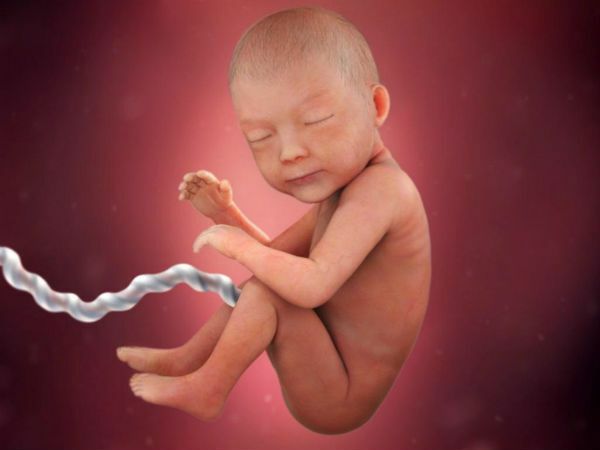
Fetal size is more than 40 cm, weight - 1,3-1,5 kg. Nerve cells function, nerve fibers are formed. The fetus reacts consciously to irritations. The formation of genital organs is coming to an end. The sensations of a woman are the same as in the previous weeks. The abdomen impedes the accomplishment of many habitual actions. It is impossible to lean forward.
to contents ^31st week
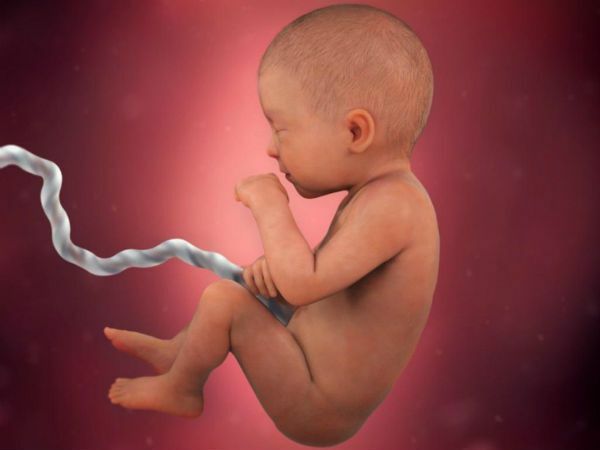
Fetal size - 41 cm, weight - 1,5 kg. Pancreatic cells produce insulin. The liver performs a detoxification function, that is, filters the blood and cleanses toxins. The brain of the fetus is 1/4 of the organ of an adult. There is a corneal reflex, which consists in squinting the eyes when the cornea touches foreign objects.
The woman's metabolism increases, so sweating increases. Feels dizzy in the supine position.
to contents ^32nd week
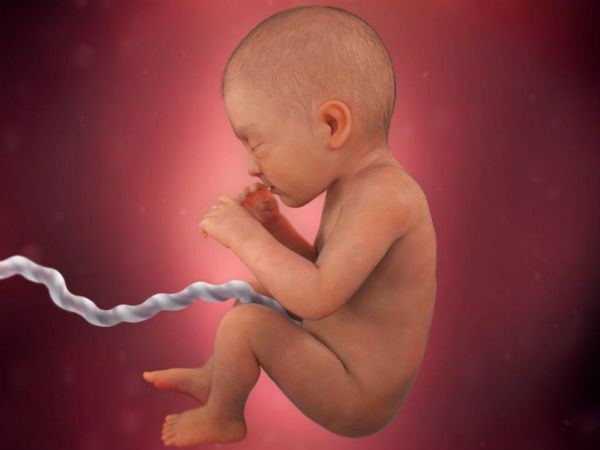
Fetal size - 43 cm, weight - 1,7-1,8 kg. At this time the fetus takes an optimal position for childbirth - upside down. The baby's skin is smoothed and takes on a natural shade. The growth of the abdomen is accompanied by itching and the appearance of stretch marks. Disturbing insomnia, sleep becomes more troubling in connection with the approaching birth.
to contents ^33rd week
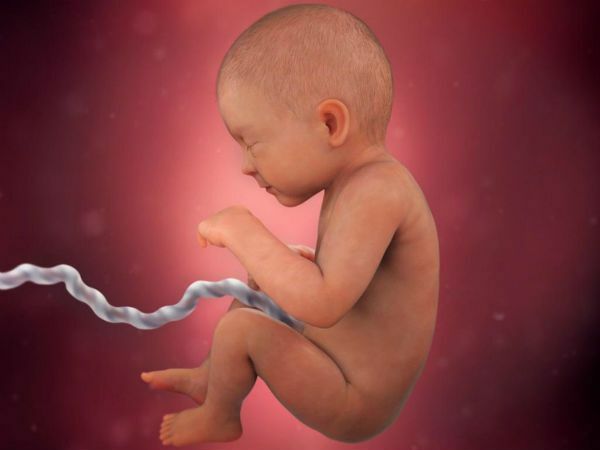
Fetal size - 44 cm, weight - about 2 kg. The immune system functions, antibodies are produced. The body became proportional, rounded, cheeks appeared on the face. Nails grow on the fingers. The child reacts to light and sounds, feels the emotions of the mother. Therefore, stressful situations should be avoided. A woman may be bothered by itching in the chest and abdomen.
to table of contents ^34th week
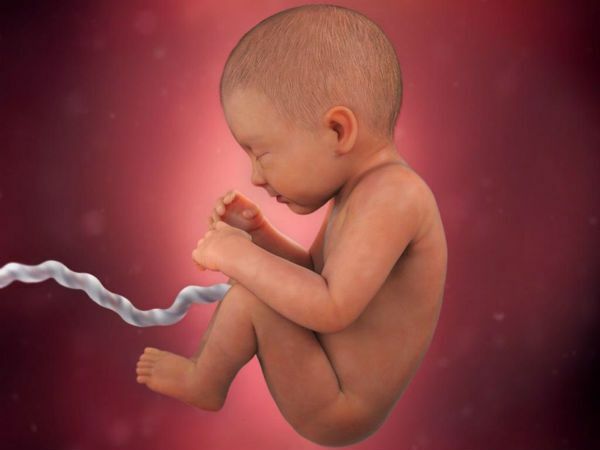
Fetal size - 45 cm, the weight is already slightly more than 2 kg. Thyroid gland and adrenal glands produce 10 times more hormones than an adult. Nails grew to the end of the nail plate. Hairs on the head have a native pigment. A woman can roughly determine the character of a future baby by his activity. The child should move almost every hour, if awake.
to contents ^35th week
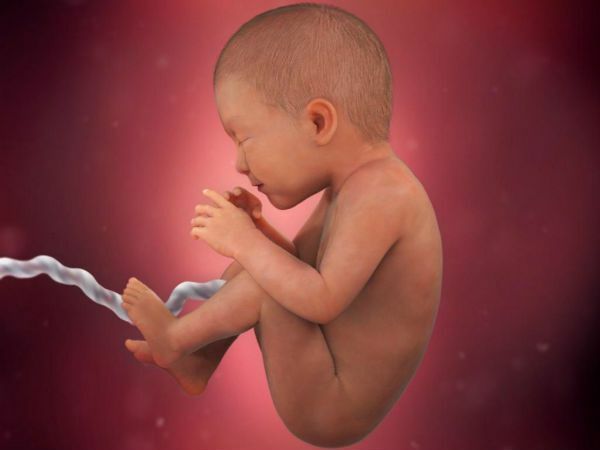
Fetal size - 46 cm, weight - 2,4 kg. Muscle and fat mass are increased. Nails become long, so the fetus can scratch itself. The immune system continues to improve, however, the production of antibodies is not enough to fully protect against infections.
By the 35th week, fatigue accumulates, especially because of permanent low back pain. The digestive organs can hardly cope with their task because of the increased pressure.
to contents ^36th week
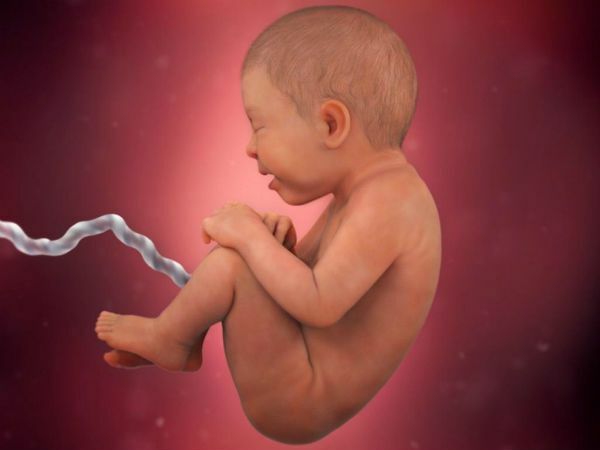
Fetal size - 47 cm, weight exceeds 2.6 kg. In the brain formed a center that coordinates the work of the cardiovascular system, breathing and thermoregulation. Immediately after the birth of the child, these systems are ready for work. The fruit continues to develop the skills of the sucking reflex.
A woman feels growing anxiety and panic. Therefore, increased nervousness and irritability, which prevents a full sleep.
to contents ^37th week
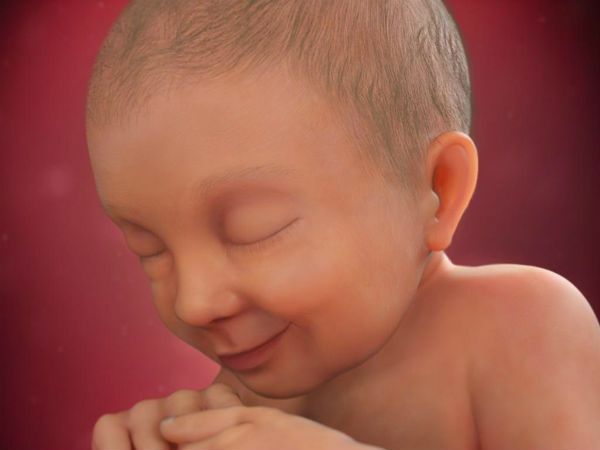
Fetal size - 48-49 cm, weight - about 2950 grams. In the brain, the centers for controlling respiration, cardiac activity, and movement are being improved. In the respiratory tract, a surfactant is produced, which will help the baby to open up after birth. All the muscle groups of a woman are tense. The pain and tension of the mother grows closer to the evening.
to contents ^38th week
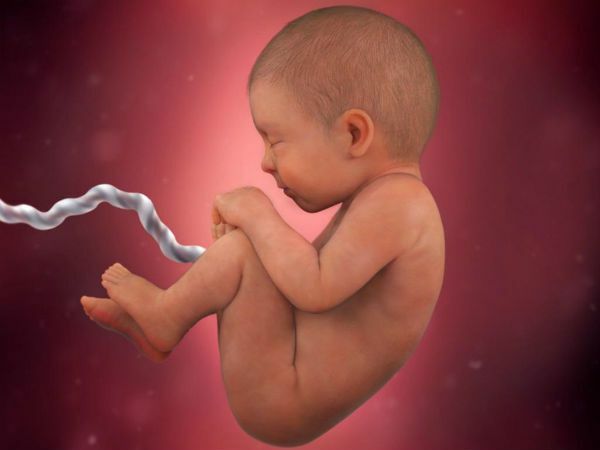
Fetal size - 49-50 cm, weight - 3.1 kg. The skeleton of the child becomes stronger every day, only the cranial bones remain soft and are joined by cartilages. After birth, the bones will harden. The color of the eyes is not fully formed due to the lack of pigment. The anxiety of the future mother in connection with the impending birth is intensifying. Panic disturbs both in sleep and during wakefulness.
to contents ^39th week
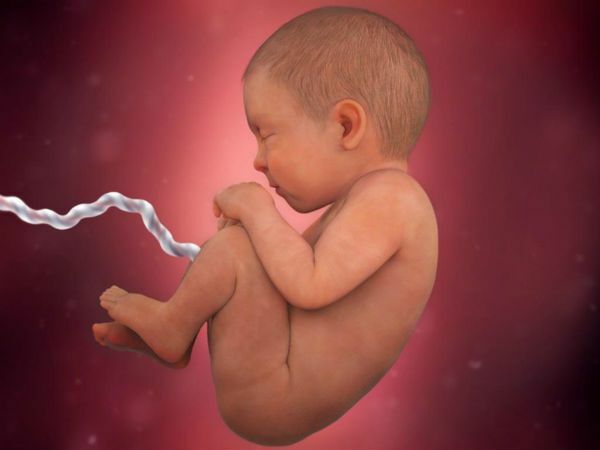
Fetal size - 50-53 cm, weight - 3250 grams. In the intestine formed the original feces( meconium), which will be released after birth. The fetus moves less because of the tightness in the womb. Mothers find it difficult to grasp the movement.
Possible symptoms of a pregnant woman - a fossil of the abdomen, an increase in the tone of the uterus, pulling back pain, dilution of stool. In the near future, the mucous plug will move away. It is necessary to trace these signs of approaching births.
to contents ^40th week
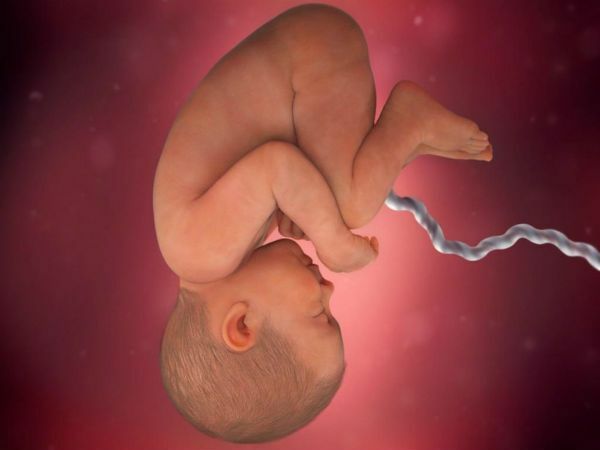
The fruit size is more than 51 cm, weight is about 3.5 kg. The baby rolls over and, as a rule, delivery comes on this week. The baby moves about 10 times a day. The mucous plug comes out, the amniotic fluid leaves. Mild nausea and thinning of the stools appear one day before the birth. The weight of the woman is kept or reduced. The abdomen is lowered, so the urges to the toilet become frequent and there is incontinence.
